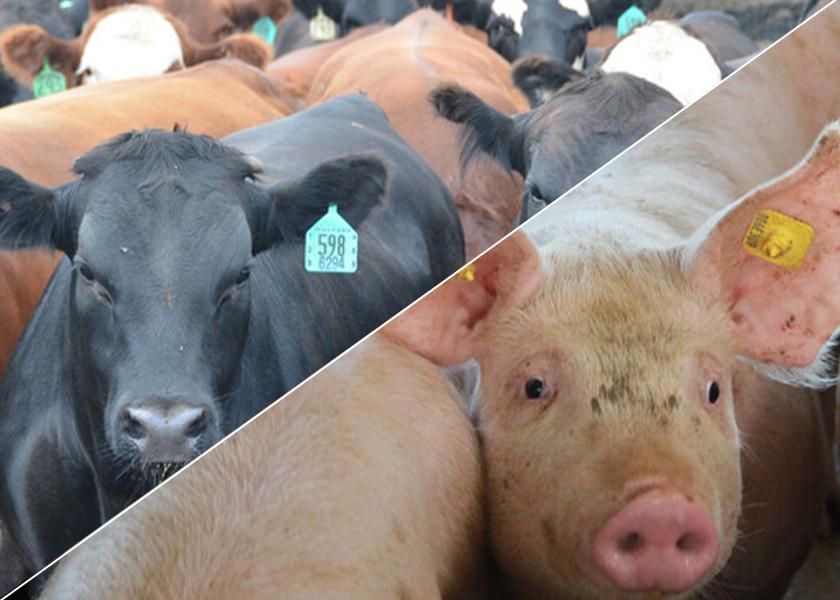Livestock Analysis | August 5, 2022

Hogs
Price action: Expiring August hog futures rose 17.5 cents to $120.825 on Friday. Most-active October futures rallied 80 cents to end the week at $98.40; that represented a weekly gain of $1.175.
5-day outlook: Despite several pork plants granting their workers a floating holiday on Monday, this week’s preliminary hog kill reached 2.34 million head. That topped the week-ago figure by 49,000 (2.1%) and the year-ago total by 13,000 (0.6%). This was the first time the weekly kill topped the year-ago result since the week of Independence Day, so we see little reason to think our expectations for hog supplies to run 1%-2% under year-ago rates are incorrect. However, the increase probably presages the long-awaited seasonal supply surge expected to send cash hog prices tumbling through the second half of the year. That might partially explain the recent slide in wholesale pork values, which reached $124.49 at noon today after having surged to $131.02 Tuesday. However, the lean hog index remains strong, with Thursday’s preliminary figure at $121.86 marking a 25-cent rise from Wednesday’s official result at $121.61. The August futures close implies traders expect a modest decline next week.
30-day outlook: The 10-year average implies weekly hog slaughter rises about 125,000 head per week between the first and last weeks of August, which goes far toward explaining the cash market weakness often experienced during the run-up to Labor Day. We suspect the rise will prove more modest this year due to the ongoing cyclical contraction of the hog supply. Moreover, it seems rather likely that the demand that powered pork prices to their annual highs during the past 10 days will persist, especially if cattle and beef prices remain strong. Relative cash and wholesale firmness could spur buying in October and December hog futures, since those contracts are priced well below current cash values.
90-day outlook: The hog and pork complex’s strong tendency for seasonal weakness, which has averaged around $11.00 from early August to mid-October and about $22.00 from now until the end of the year, explains the large discounts built into the fourth-quarter contracts. Hog supplies are set to surge seasonally, whereas demand for most pork cuts declines during the fourth quarter. As usual at this time of year, the big question for producers, packers and traders is how large those declines will ultimately prove to be. Again, we are inclined to expect a relatively modest seasonal decline in late 2022, due in part to anticipated cattle/beef strength and to the modest cyclical hog supply drop currently predicted. We are also sticking to the idea that consumers boost their red meat buying during recessionary times due to reduced restaurant visits and more eating at home. This suggests fourth-quarter hog futures are undervalued.
What to do: Be prepared to extend feed coverage when market bottoms are in place.
Hedgers: Carry all risk in the cash market for now.
Feed needs: You are hand-to-mouth on corn-for-feed and soybean meal needs.
Cattle
Price action: Expiring August live cattle futures ended the week rising 17.5 cents to $137.875, while most-active October gained 22.5 cents to $143.875. The October close marked a $2.55 weekly advance. September feeder futures advanced 85 cents and settled at $183.425, up $1.875 on the week.
5-day outlook: Beef packers apparently relied heavily upon previously purchased cattle, contracted and formula-based animals to fill out their slaughter schedules during late July, hoping to put pressure on cash prices. The sizeable cash gains (around $1.50) posted this week imply that didn’t work, which in turn suggests the upward price pressure will persist through mid-August. On the other hand, history shows slaughter rates tend to increase during the run-up to Labor Day. Packers may be relying upon the indicated supply increase to keep a lid on prices. We’re rather skeptical on this score, since grocers will probably accelerate their wholesale beef purchases as they prepare for beef features for Labor Day weekend. Cash and futures prices seem likely to work higher.
30-day outlook: Grocer beef buying for Labor Day seems to fall short of the rates/levels reached during preparations for Memorial and Independence Day celebrations. That may simply reflect the impact of students returning to school. On the other hand, beef buying for school lunch programs is probably picking up as well (although administrators are unlikely to buy a lot of steaks). In fact, the seasonal demand shift away from steaks toward roasts is possibly one reason the cattle market often doesn’t prove as strong in late summer as it was during spring. Still, with feedlot marketings apparently proving quite current this summer, we see little reason to expect short-term price weakness in the cattle/beef marketing chain.
90-day outlook: Seasonal factors suggest fed cattle prices will continue working their way higher through late summer and fall. Indeed, the historical pattern is for the gains to persist through winter. A large portion of the seasonal price gain is likely supply-driven, since feedlot placements generally reach their lowest levels of the year in the second-quarter, particularly in June. That suggests fed cattle supplies will reach their lowest levels of the year in the fourth quarter, but summer-fall placements are greatly supplemented by increasing numbers of heavy calves in the mix. Those likely won’t finish until spring. Conversely, fall and winter cattle slaughter is boosted by heavy cow sales as ranchers sell those that performed poorly or weren’t bred during summer. We expect cattle prices to move unevenly higher over the coming quarter, especially if feedlot managers keep marketings current.
What to do: Be prepared to extend feed coverage when market bottoms are in place.
Hedgers: Carry all risk in the cash market for now.
Feed needs: You are hand-to-mouth on corn-for-feed and soybean meal needs.






